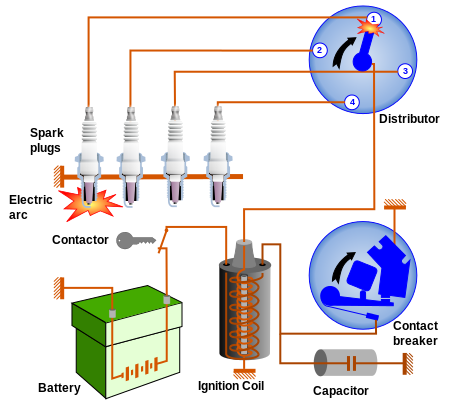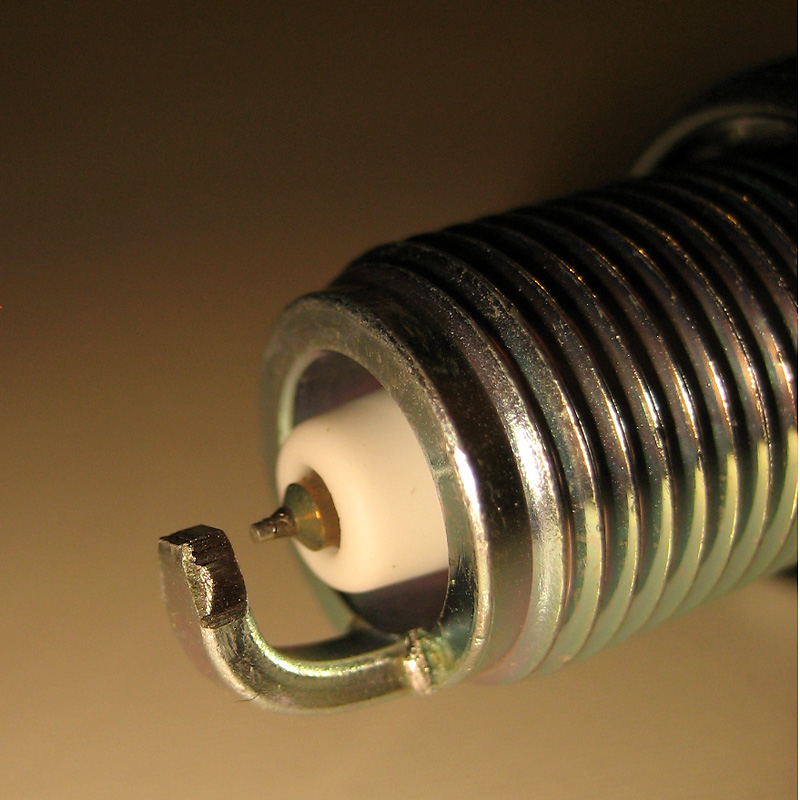The Physics in Cars
The Ignition System
The ignition system is one of the two main systems that makes it so that your car is running, if you car is not working chances are something went bad with your ignition system. The ignition system works by taking power from the battery and sending this power through various devices then finally get to the combustion chamber where it arcs and ignites the fuel within the cylinder. There are 4 main parts to the ignition system including the battery, ignition coil, distributor, and spark plugs.

(Wikipedia Ignition) Diagram of the ignition system
The first part of the system is the battery, This is the device that holds and stores power until it is required for any number of things from your stereo to the starter. The battery is a 12v direct current power source that has a positive and negative terminal. The battery can be different depending on the vehicle and where you are located and how they are built. Some have higher amps in them for colder weather and some have different designs within them but the one thing that is constant is the voltage in them. Some vehicles like diesel trucks that need more power will have two batteries that are hooked up in parallel or in series depending on if they just need more current or if they require higher voltage. The batteries main job is to make sure there is power to be used to ignite the fuel.
The second part is the ignition coil, which is a a small part that acts as a transistor with a capacitor that builds up charge until the circuit is complete and it discharges the power to the distributor. The ignition coil is constructed of two sets of coils and a rod that activates by induction. There is a set of windings in the coil with a primary and secondary winding set where one set has significantly more coils in it that act as a step up transformer that increases the voltage as it is released. The ignition system relies on a spark jumping across a small gap on the spark plug which doesn't seem that difficult but in the combustion chamber is a very harsh place that is hot and under pressure and not to mention the presences of gasses and liquids. This is where the ignition coil comes into play. It converts the batteries 12 volts into much larger amounts of voltage into the tens of thousands of volts and discharges it to the plug when it is needed. This increase in the voltage is necessary to bridge the 0.060" gap that is on the plug and create a spark that will ignite the gas in the chamber.

(Wikipedia ignition) An ignition coil.
The third part of the system is the distributor, which is a part that connects to the engines cam shaft and relays the power coming from the battery and ignition coil down to the individual plugs. The distributor is one of the simpler parts of the system as it essentially acts as a switch that is continually rotating to connect with the various points of contact around the cap. The cap is where the plug wires connect with little electrical contacts, then there is a rotor that spins around and makes contact with the individual points and sends the power through then disconnects and moves to the next point. The distributor is basically just a switch that turns on and off as it spins. While it is not complicated to understand, it is still very important.
(Wikipedia Ignition) A distributor with vacuum advance
The last part is the spark plug, which is the end of the system where the power is sent to arc across a very small gap that ignites the fuel in your engine and makes your car go. This is a very simple part that consists of a core that is insulated and an outer metal shield that grounds to the engine block. The power flows through the core as the insulation (which is usually made of ceramic) prevents any shorts in the plug and makes sure the power get to the end and jumps the gap which creates the spark. The gap that is grounded then disperses the energy to the ground. The proper gap is very important as too much gap and the spark may not jump the gap and too little would lead to an incomplete burn in the chamber.

(Wikipedia Ignition) The end of a spark plug.
That is how the ignition system works!